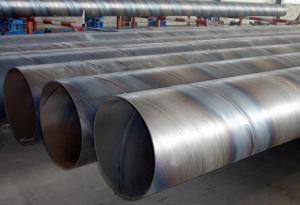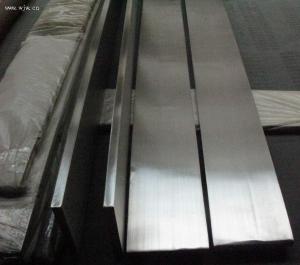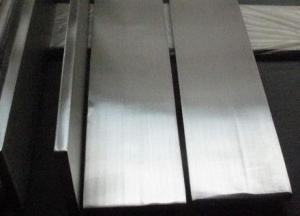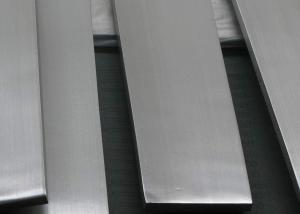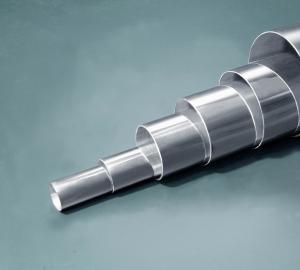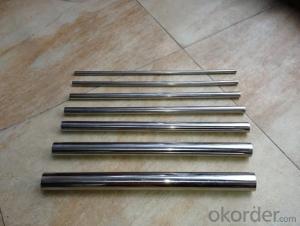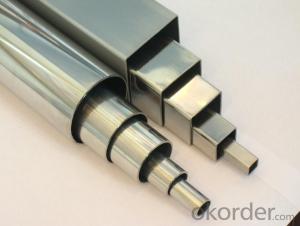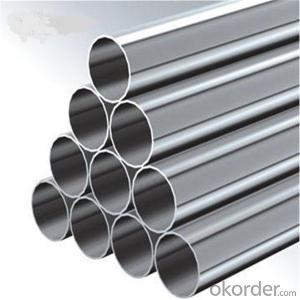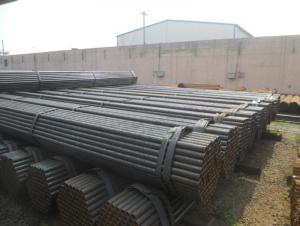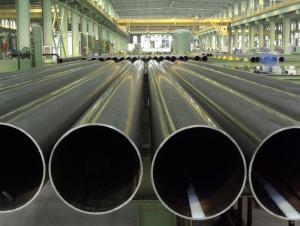High Quanlity Stainless Steel Welded Pipe
- Loading Port:
- Tianjin
- Payment Terms:
- TT or LC
- Min Order Qty:
- 25 m.t.
- Supply Capability:
- 10000 m.t./month
OKorder Service Pledge
OKorder Financial Service
You Might Also Like
1、Structure of Welded Steel Tube:
We are company that have many years experience and professional manager team and engineer team and sales team, sure we will provide you high quality of pipe and professioanl service.Welded Steel Tube is formed by drawing a solid billet over a piercing rod to create the hollow shell. We are company that have many years experience and professional manager team and engineer team and sales team, sure we will provide you high quality of welded pipe and professioanl service.
2、Main Features of the Welded Steel Tube:
• High manufacturing accuracy
• The higher strength
• The small inertia resistance
• Strong heat dissipation ability
• Good visual effect
• Satisfy price
3、Welded Steel Tube Specification:
Standard | GB, DIN, ASTM ASTM A106-2006, ASTM A53-2007 |
Grade | 10#-45#, 16Mn 10#, 20#, 45#, 16Mn |
Thickness | 8 - 33 mm |
Section Shape | Round |
Outer Diameter | 133 - 219 mm |
Place of Origin | Shandong, China (Mainland) |
Secondary Or Not | Non-secondary |
Application | Hydraulic Pipe |
Technique | Cold Drawn |
Certification | API |
Surface Treatment | factory state or painted black |
Special Pipe | API Pipe |
Alloy Or Not | Non-alloy |
Length | 5-12M |
Outer Diameter | 21.3-610mm |
Grade | 20#, 45#, Q345, API J55, API K55, API L80, API N80, API P110, A53B |
Standard | ASME, ASTM |
1) Material:20#(ASTM A 106/A53 GRB.API5LGRB,GB),45#,16Mn,10#.
2) Specification range:OD:21.3-610mm,WT:6-70mm,length:6-12m or according to the requirement of clients.
3) Excutive standards:GB,ASME API5L.ASTM A 106/A53,Despite of the above standards,we can also supply seamless steel pipe with standard of DIN,JIS,and so on,and also develop new products according to the requirements of our clients!
4) Surface:black lacquered,varnish coating or galvanized.
5) Ends:Beveled or square cut,plastic capped,painted.
6) Packing:bundles wrapped with strong steel strip,seaworthy packing.
4、Packaging & Delivery
Packaging Details: | seaworthy package,bundles wrapped with strong steel strip |
Delivery Detail: | 15-30days after received 30%TT |
5、FAQ of Welded Steel Tube:
①How is the quality of your products?
Our products are strictly in accordance with international and domestic standard. We test on every pipe before delivery. Any quality certification or testing report you want to see, please tell us.
Guaranteed: If products’ quality is not in accordance with description as we provide or the promise before you place order, we promise 100% refund.
②How about the price?
Yes, we are factory and be capable of offering you the lowest price. One of our policy is that “ to save time and be absolutely honest with our business relationship, we quote as low as possible for every client, and discount can be given according to the quantity”, if you are interested in bargain and dissatisfy our factory price, just don’t waste your time. Our quotation is professional.
③Why should you choose us?
Choice happens because of our quality and price. Additionally, we can also offer professional products inquiry, products knowledge train (for agents), fast goods delivery, outstanding customer solution proposals. Our service formula: good quality + good price + good service=customer’s trust.
SGS test is available. Customer inspection before shipping is welcome. Third party inspection is OK.
6、 Welded Steel Tube Images:


- Q: What is the difference between seamless and precision stainless steel pipes?
- Seamless and precision stainless steel pipes differ in their manufacturing process and performance characteristics. Seamless stainless steel pipes are produced through the extrusion or piercing process, where a solid cylindrical billet is heated, and then a piercing rod is used to create a hollow tube. This process ensures that there are no seams or welds in the pipe, resulting in a smooth and uniform surface. The absence of seams eliminates the risk of leakage or weak points, making seamless pipes highly reliable and suitable for various applications. On the other hand, precision stainless steel pipes are manufactured through the cold-drawn or cold-rolled process. In this method, a seamless pipe is further processed to achieve precise dimensions, tolerances, and surface finishes. The precision process enhances the mechanical properties of the pipe, such as its strength, hardness, and durability. Precision pipes are commonly used in industries where tight tolerances and superior surface quality are required, such as automotive, aerospace, and medical applications. In terms of performance, seamless stainless steel pipes offer excellent corrosion resistance, high temperature resistance, and good mechanical properties. They are often used in industries such as oil and gas, chemical processing, and power generation, where reliability and strength are crucial. Precision stainless steel pipes, on the other hand, are known for their dimensional accuracy, smooth surface finishes, and superior mechanical properties. They are commonly used in precision engineering, instrumentation, and high-performance applications. In summary, the main difference between seamless and precision stainless steel pipes lies in their manufacturing process and intended applications. Seamless pipes are produced without any seams, providing excellent reliability, while precision pipes are further processed to achieve precise dimensions and superior surface quality for specific industries and applications.
- Q: What is the difference between SCH and XS stainless steel pipes?
- Two distinct schedules or pipe thicknesses are employed in stainless steel pipes, namely SCH and XS. SCH represents schedule, while XS signifies extra strong. The primary disparity between SCH and XS stainless steel pipes can be found in their wall thickness. SCH pipes possess a standardized thickness range, whereas XS pipes exhibit a thicker wall in comparison to SCH pipes. SCH pipes are commonly utilized for general-purpose applications where elevated pressure is not a significant concern. They are available in various schedules, such as SCH 5, SCH 10, SCH 40, and so forth. The schedule number increases as the wall of the pipe thickens. SCH pipes are suitable for applications involving low to medium pressure. Conversely, XS pipes are engineered to withstand higher pressure and are frequently employed in more demanding scenarios. XS pipes possess a thicker wall than SCH pipes, offering enhanced strength and durability. They are prevalent in industries such as oil and gas, chemical processing, and power plants, wherein high pressure and corrosive environments are prevalent. To summarize, the primary distinction between SCH and XS stainless steel pipes lies in the thickness of their walls. SCH pipes possess a standardized thickness range, while XS pipes exhibit a thicker wall specifically tailored for high-pressure applications.
- Q: Can stainless steel pipes be insulated with polyetherimide?
- Polyetherimide (PEI) is an exceptional thermoplastic that exhibits remarkable thermal stability and insulation capabilities, making it a suitable choice for insulating stainless steel pipes. With its excellent resistance to heat, chemicals, and electrical conductivity, PEI can effectively insulate stainless steel pipes in diverse industries such as oil and gas, chemical processing, and aerospace. Moreover, PEI's high glass transition temperature enables it to withstand elevated temperatures without melting or deforming, further enhancing its appropriateness for insulating stainless steel pipes.
- Q: Can stainless steel pipes be used for chemical refineries?
- Indeed, chemical refineries can utilize stainless steel pipes. Stainless steel possesses exceptional resistance to corrosion, rendering it an appropriate option for the management of diverse chemicals and corrosive substances prevalent in refineries. It provides exceptional strength, durability, and high temperature resistance, making it an ideal choice for the arduous conditions and demanding settings within chemical refineries. Moreover, stainless steel pipes are effortless to clean and maintain, a critical aspect in industries where cleanliness is of utmost importance to prevent contamination or compromise product quality. In summary, stainless steel pipes are extensively employed in chemical refineries due to their corrosion resistance, strength, and long lifespan.
- Q: What are the different types of fittings used with stainless steel pipes?
- Stainless steel pipes can be paired with various types of fittings, depending on the specific needs and application. Here are some of the most commonly used fittings: 1. Compression fittings: These fittings create a tight, leak-proof connection by compressing a ferrule onto the pipe. They work well with both rigid and flexible stainless steel pipes and are easy to install. 2. Threaded fittings: Known as screwed fittings, these have female threads that can be screwed onto the male threads of the pipe. They are commonly used in low-pressure situations and can be easily installed or removed. 3. Butt weld fittings: These fittings are used to make a permanent, welded connection between two stainless steel pipes. The pipes need to be beveled to create a V-shaped groove, and they are typically used in high-pressure or high-temperature settings. 4. Flange fittings: Flanges are utilized to connect two stainless steel pipes or connect a pipe to a valve, pump, or other equipment. They provide a strong and leak-proof connection and can be bolted or welded onto the pipe. 5. Push-to-connect fittings: These fittings offer a quick and tool-free connection. They use a push-in mechanism to secure the pipe and are commonly used in plumbing and air compression systems. 6. Camlock fittings: Camlock fittings enable rapid connection and disconnection of hoses and pipes. They have a lever or cam mechanism that locks the fitting into place, ensuring a secure connection. These fittings are often used in industrial settings where frequent connections and disconnections are necessary. Ultimately, the choice of fitting depends on factors such as the application, pressure requirements, and ease of installation. It is crucial to select the appropriate fitting to guarantee a reliable and long-lasting connection for stainless steel pipes.
- Q: How do you pressure test stainless steel pipes?
- To ensure the integrity and safety of stainless steel pipes, it is crucial to conduct pressure testing. Below is a step-by-step guide on how to perform pressure testing on stainless steel pipes: 1. Pipe Preparation: Before initiating the pressure test, make sure the stainless steel pipes are clean and devoid of any debris or contaminants. Inspect the pipes for visible defects like cracks or leaks and repair or replace them if necessary. 2. Gathering the Necessary Equipment: You will require a pressure testing pump or equipment capable of generating the desired pressure, pressure gauges, and appropriate seals or plugs to seal the pipe ends. 3. Determining the Required Pressure: Refer to engineering specifications or relevant industry standards to determine the suitable pressure for testing the stainless steel pipes. The pressure is usually indicated in pounds per square inch (psi). 4. Sealing the Pipe Ends: Use suitable seals or plugs to securely seal all the ends of the stainless steel pipes. This will prevent any leakage during the pressure test. 5. Connecting the Pressure Testing Equipment: Connect the pressure testing pump or equipment to one end of the pipe using a pressure gauge to accurately monitor the pressure. Ensure that the connections are tight and leak-proof. 6. Applying Pressure Gradually: Gradually increase the pressure in the stainless steel pipes using the pressure testing pump or equipment. Keep a close eye on the pressure gauge and ensure it reaches and stabilizes at the desired testing pressure. This gradual process avoids sudden pressure surges that could potentially damage the pipes. 7. Maintaining the Pressure: Maintain the pressure at the desired level for a specified duration as recommended by engineering specifications or standards. The duration can vary from a few minutes to several hours depending on the application and requirements. 8. Leak Inspection: While maintaining the pressure, carefully inspect the stainless steel pipes for any signs of leakage. Look for visible leaks, listen for hissing sounds, or use leak-detection solution or soapy water to identify any escaping air or bubbles. If leaks are detected, halt the pressure test and address the issue before proceeding. 9. Releasing the Pressure: Once the pressure test is completed, gradually release the pressure from the stainless steel pipes using the pressure testing pump or equipment. Be cautious while releasing the pressure to prevent sudden decompression that could potentially damage the pipes. 10. Evaluating the Results: After the pressure test, inspect the stainless steel pipes again to ensure no new leaks or defects have emerged. If the pipes have successfully passed the pressure test without any issues, they can be considered safe and suitable for their intended application. It is important to note that pressure testing stainless steel pipes should only be carried out by qualified personnel following industry standards and guidelines to ensure accuracy and safety.
- Q: What is the difference between 347 and 321 stainless steel pipes?
- The main difference between 347 and 321 stainless steel pipes lies in their composition and intended use. 347 stainless steel contains a higher amount of niobium, which enhances its resistance to intergranular corrosion, making it suitable for high-temperature applications. On the other hand, 321 stainless steel has titanium as a stabilizing element, providing improved resistance against sensitization during welding.
- Q: Can stainless steel pipes be used for architectural applications?
- Yes, stainless steel pipes can be used for architectural applications. Stainless steel is known for its durability, corrosion resistance, and aesthetic appeal, making it an excellent choice for various architectural projects such as railings, handrails, facades, and decorative elements. Its versatility, strength, and ability to withstand harsh weather conditions make it an ideal material for architectural applications.
- Q: Can stainless steel pipes be pressure tested?
- Indeed, it is possible to subject stainless steel pipes to pressure testing. The purpose of pressure testing is to expose the pipes to elevated pressure levels, surpassing those encountered in regular operations, in order to verify their robustness and reliability. Stainless steel is renowned for its resilience and capacity to endure high-pressure circumstances, thereby rendering it fitting for pressure testing purposes. The procedure entails filling the pipes with either a liquid or gas and progressively escalating the pressure to the intended level, all the while vigilantly inspecting for any signs of leakage or malfunctions. To guarantee precise outcomes and avert potential dangers, it is imperative to adhere to proper protocols and safety precautions throughout the pressure testing process.
- Q: What is the difference between seamless and extruded stainless steel pipes?
- The main difference between seamless and extruded stainless steel pipes lies in their manufacturing process. Seamless stainless steel pipes are produced by piercing a solid billet of stainless steel and then rolling it to the desired shape and size without any seams. On the other hand, extruded stainless steel pipes are created by forcing the molten stainless steel through a die to form the desired shape. This process results in a seamless pipe with consistent thickness throughout. In summary, seamless pipes are made by rolling a solid billet while extruded pipes are formed by forcing molten stainless steel through a die.
Send your message to us
High Quanlity Stainless Steel Welded Pipe
- Loading Port:
- Tianjin
- Payment Terms:
- TT or LC
- Min Order Qty:
- 25 m.t.
- Supply Capability:
- 10000 m.t./month
OKorder Service Pledge
OKorder Financial Service
Similar products
Hot products
Hot Searches
Related keywords
